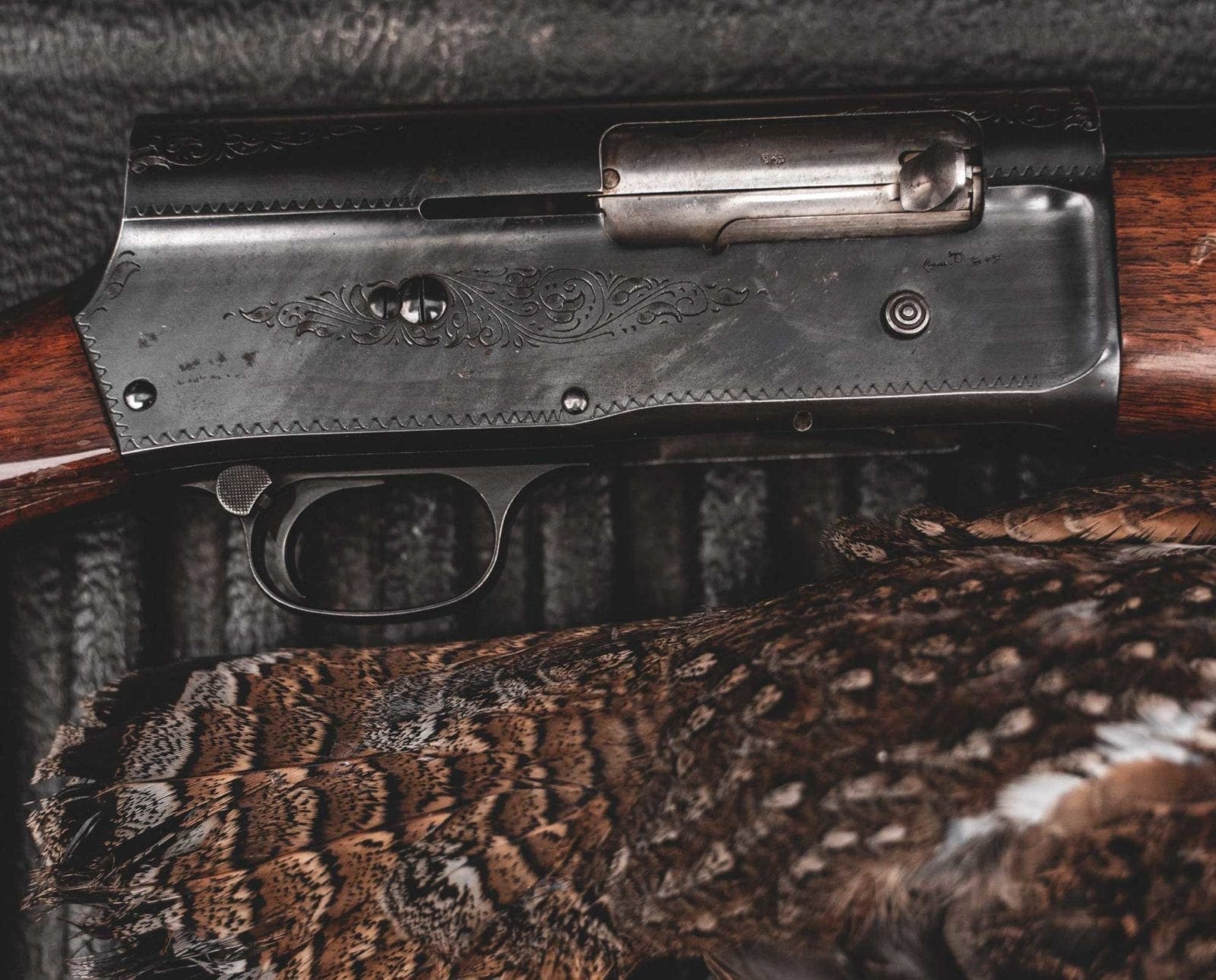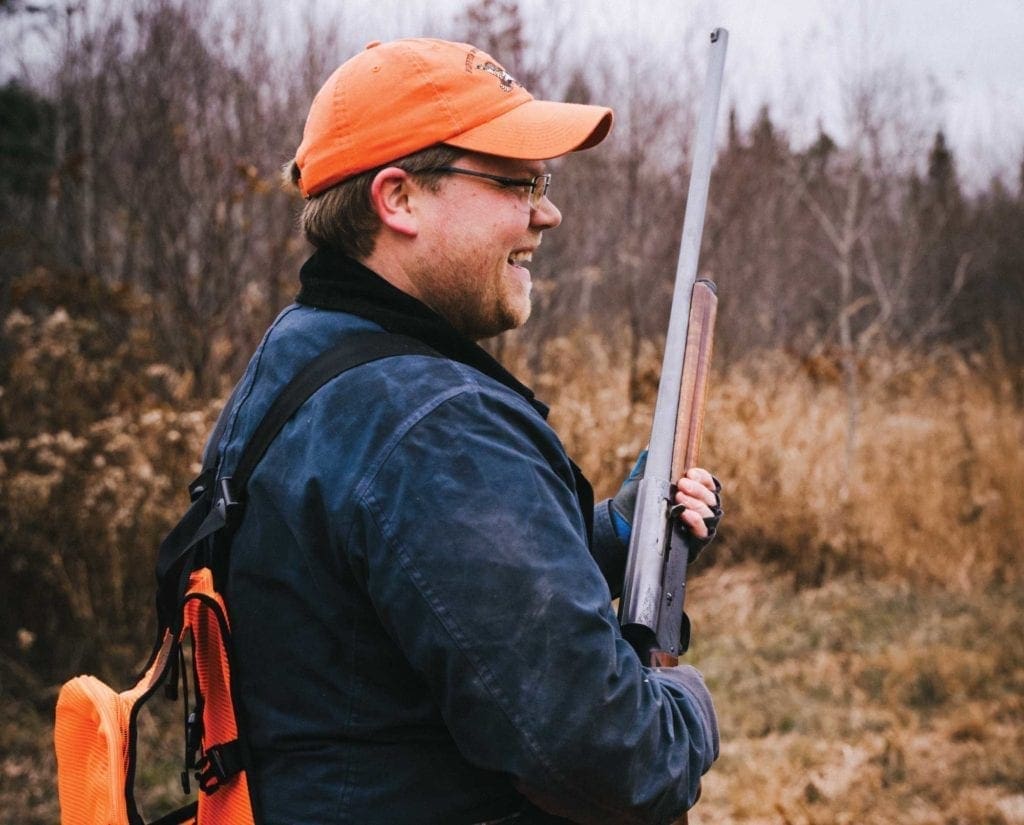Home » Firearms and Shooting » Shotguns » Browning A5 Shotgun – The Legacy of Browning’s Auto 5
Browning A5 Shotgun – The Legacy of Browning’s Auto 5

Michael Neiduski lives in North Carolina where he works for…
The Browning Auto 5 holds a legacy inside the upland hunting community for American shotgun designs
Workhorses. Do-it-all tools for any species on the wing. They may not be elegant, or carry an air of sophisticated aesthetic, but there aren’t many heirloom semi-autos in the shotgunning world that hold a candle to John Browning’s Auto 5 (now affectionately known as the A5) in many categories. Utility. Durability. Capability. Nostalgia.
Four of them take up space in my cabinet. All 12-gauges. All family pieces with unique stories to tell. Some uncovered, some lost in the ether forever. I grew up in a construction family. Tools are important to us, meant to be used. They have a role, a place, a purpose.
History of the Browning Auto 5
Developed in 1902, Browning shopped the design around, Winchester refused his terms and an agreement with Remington came unglued when their president died of a heart attack as they worked out terms. Browning then turned to Fabrique Nationale de Herstal (now known as FN), where he had an established relationship as they manufactured many of his pistol designs.
FN produced the A5 in Belgium until 1975, with a brief break during World War II when production shifted to Remington from 1940-46, and lastly to Miroku in Japan starting in 1975 until the traditional A5 ceased production in 1999. Mr. Browning additionally licensed the A5 design to Remington, which produced the Model 11, and Savage for the model 745. Browning reintroduced the A5, produced in Portugal, in 2014; however, the only thing this version has in common with the original is its exterior style.
My grandfather’s Browning A5
I only remember one of them getting used on the farm growing up. My grandfather’s A5, a 1957 build from FN Herstal in Belgium. It came out to shoot a turkey then got put up in the corner of the barn. It stayed there for the better part of 10 years until my parents cleaned the space out, and it made its way to their safe. It’s in really rough shape now. Pitted. Rusty. The wood so dried out it was damn near pale when I took it over. A friend reworked the stock, brought some life back to it. The metal needs a trip to Turnbull Restoration. It might not even be usable afterwards, but better to sit in my office as a reminder of where I came from, and to clean those still in rotation, than to disintegrate.
He killed a lot of birds with that gun. A few deer too. That was back when south central Massachusetts still had wild pheasants. Before migratory bird populations plummeted and the switch to steel shot made shooting the fixed modified choke obsolete. Well before my time.
My great-grandfather’s A5
Then there is my great-grandfather’s behemoth. A 32 inch fixed full choke 12-gauge Magnum upping the capability from 2 ¾ to 3 inch shells. The metal’s patina unveils the long barrel’s utility since its creation in 1958. When I pulled it out of the case the rubber butt pad had succumbed to dry rot, crumbling in on itself. I could see clean through the split down the side of the forearm to the shell tube. A bolt was added to the end of the piece to hold it together and keep it running. With the metal in great shape but the wood out of commission completely, it required a total re-stock. It’s an interesting juxtaposition, the old graying metal with brand new wood and pristine checkering. The wood will get its character in time, quickly becoming my go-to for the trap range, late season pheasants, and an occasional duck hunt.
A family friend’s A5 Light 12
Next up is the Light 12, made lighter with the shortening of barrels, no rib, and a hollowed butt-stock. The 1955 model was primarily used as a deer gun with the receiver drilled and tapped for a side-mount scope. “Light” is a bit of a misnomer in the current sense, weighing in around 7 pounds 12 ounces, but compared it carries well and comes up just as easy with a smooth swing. When I took it apart for cleaning I learned this iteration wasn’t a family gun, but at one time was owned by a man on my grandfather’s construction crew; a neatly folded note tucked into the hollow butt stock held his name and phone number.
This one also needed some TLC on the stock, a crack showed on the grip and along the forearm. Old model A5s are notorious for these imperfections, generally a function of misaligned friction rings. One of the many unique characteristics of the A5 is the sliding barrel. When the gun is fired the barrel recedes into the shotgun’s receiver, pushes the bolt back, ejects the shell, then returns to its original position. When the friction rings and spring on the magazine tube are incorrectly installed the ring affixing the barrel to the tube slams into the receiver upon firing and then again against the forearm wood upon return, sandwiching it between the barrel ring and the magazine tube cap. As you peruse these older models keep an eye out for these stress fractures.
Misalignment of these friction rings also unfairly impacts the A5’s reputation for being a rough shooter. The rings can be aligned for both light and heavy loads which increase pressure on the spring over the magazine tube. Often these rings are installed incorrectly after owners strip and clean the gun, or as I discovered on one of my guns, the rings are missing altogether.
This stock too went to my friend to be stripped, re-finished, and repaired. I only took the Light 12 afield once this fall, a clear morning in northern Wisconsin where we quickly found ourselves in the midst of a woodcock flight, popcorn flushes all over this particular cover. I took each of the three woodcock I pulled the trigger on in that particular cut, three for three. Not wanting to ruin the streak I wiped the gun down and cased it upon returning to the truck.
Buying a Browning Auto 5
John Browning’s A5 became the second best selling auto-loader in history, coming in second only to Remington’s storied 1100. Because of this, A5s can be readily found at gun shops and online auctions in various stages of use and repair. Every time I stop at a shop I’m drawn to the familiar hump backed receiver and round knobbed grip. Every time I pick one up and check the mount, every time the alignment is right where it should be, right down the line.

Used 12-gauge models can be found anywhere from $400-$1,000 depending on condition and manufacturer location, those on the lower end typically needing significant stock repair or replacement. As with any shotgun, the cost of sub-gauges escalates, particularly for light 16-gauge models. Belgian made Sweet Sixteens in great condition can sell for $2,500 or more with new-in-box models approaching $5,000.
My father’s Miroku-made A5
The last of the four is arguably my favorite, my father’s 1980 Miroku-made Magnum. My father had a Belgian made A5 and used it alongside my grandfather for New England ducks, geese, and pheasants growing up. It too became my preferred companion for waterfowl sunrises. He pawned it before I was born, a decision made in the fog of an unclear mind in hard times. When the fog lifted he picked up this version as a form of penance.
It’s easy to see the difference between this version and the previously made Belgian models—darker, almost chocolate wood, sharper lines, no more Prince of Wales knob in the grip. But the internals are the same and it comes up to my eye just the same upon mounting. The Miroku versions don’t hold the same nostalgia or consumer desire as their Belgian counterparts, but they are just as capable. They may not have the same sexy history as the sought after “Belgian made Browning” but I am a sucker for sentiment and the story behind my father’s Miroku A5 resonates deeply with me. Loss, perseverance, returning to the fold the same, yet different. Capable. Durable despite change. A workhorse with purpose meant to be used.
Michael Neiduski lives in North Carolina where he works for the RGS and AWS as the Regional Director of Development for the southeast. When not working he can be found volunteering for other conservation groups, judging NAVHDA tests, and plotting his next bird hunt, near or far. Want to talk conservation or versatile dogs? You can find him @mneiduski on Instagram.




great read. inherited my father’s A5. 20 gauge as used for quail. I remember being with him as a kid over 50 years ago when you bought it. a great piece.
I love that you’re focusing on this gun. I have my grandfather’s 1941 Model 11 that my dad used for everything when I was a kid. The old square backs are the classic image of American shotgunning in my opinion.
Thanks, Mark! Maybe we can get them out in the field together one day.
Art’s Gun & Sport Shop,Hillsboro,Mo, is the go to place for restoration, repairs and parts for Browning shotguns, especially A-5’s. Art Isaacson is a recognized expert on Browning firearms. He also maintains a healthy inventory of used guns. I’ve purchased several. Art and Brad, his son, are straight shooters who sell quality guns at fair prices.
Very True! One of these needs some spring work and I’m planning on getting it over to Art sometime this year. I’ve heard nothing but great things about them and their shop.
Beautifully written an outstanding shotgun your lucky to have. When I was stationed in Germany with the U. S Army the rod & gun club always had a few A5’s made by FN. Probably one of the biggest disappointing decisions I made was not buying one as they were very affordable back then considering the exchange rate of the mark to the dollar. All the best and be well.
I have a 1964 sweet 16 in mint condition I just live that gun
Miroku did make some Auto 5 models with the rounded Prince of Wales grips. And lighter colored wood. I currently use one for upland game. Mostly pheasants and sharpies. The Invector chokes do make it a bit more versatile then the older models. Wicked deadly on flying objects just like the early models.